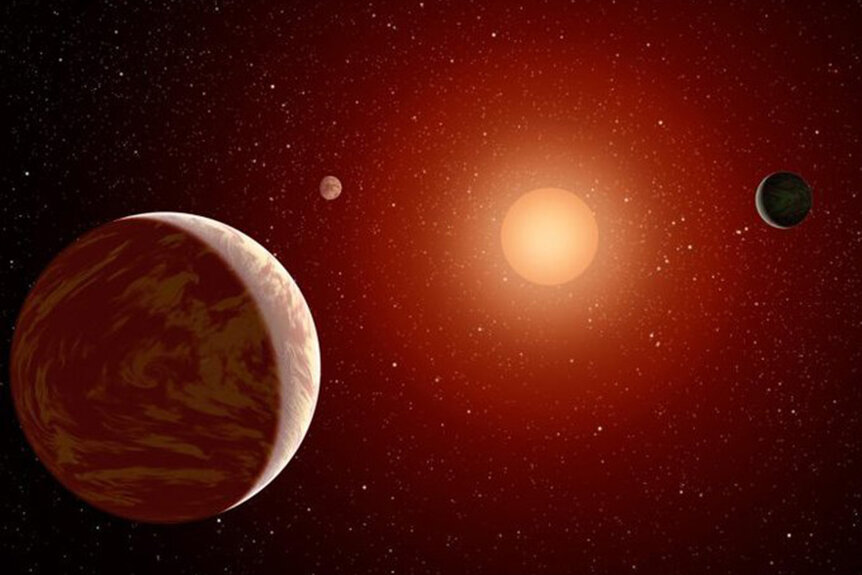Create a free profile to get unlimited access to exclusive videos, sweepstakes, and more!
Two Newly Discovered 'Super Earths' Found in Habitable Zone Around Nearby Star
Pack your bags!

The crew of the fictional Ark One had limited options when they climbed aboard their life raft to another world. You’ll take any port in a storm, and the port that’s closest is often the best. That’s why the events of The Ark (now streaming on Peacock!) take place on route to Proxima centauri, a star only 4.25 light-years from here, in the southern constellation of Centaurus.
LIVING AROUND A RED DWARF STAR
It’s a red dwarf star, only about an eighth the mass of the Sun and about a seventh of the diameter. As a result of its small stature, it gives off less heat and light than we’re used to. The crew of the Ark One are aiming for Proxima centauri b, the star’s nearest planet. It’s about the same size as the Earth (we think), with at least 1.07 times the mass (it could be much larger, if it’s orbiting at a considerable inclination) and it’s inside the star’s habitable zone. But because Proxima centauri is so itty bitty, that habitable zone is considerably closer than you might expect.
Proxima centauri b hangs out at only 5% the distance between the Earth and the Sun, and it completes an orbit every 11.2 days. While astronomers aren’t certain, it’s likely the planet is also tidally locked to the star, so that one side of the planet is constantly baked by the star while the other is in perpetual night. So much for an alien sunrise. Even if it isn’t tidally locked, going through an entire year every week and a half might make predicting the weather difficult, at the very least, and it would probably be in a 3:2 resonance with the star, resulting in a sunrise or sunset roughly every 7.5 days.
RELATED: A Dying Star Just Swallowed A Planet, Granting View To Earth’s Future
In addition to planetary weather, you also have to worry about space weather. Red dwarf stars have lower average luminosity, but they make up for it by unleashing brilliant super flares. When one of those red dwarf flares goes off, it can be 10,000 times more powerful than any solar flare ever released by the Sun. In 2016, astronomers witnessed one such super flare from Proxima centauri, resulting in a 14,000-fold increase in the star’s UV brightness, and it’s estimated that Proxima centauri releases five or six of those super flares every year.
Living on a planet around a red dwarf star would be an entirely different kind of life, which would be almost unrecognizable to anyone living on Earth, even if the ground is steady and the air is breathable. Finding a new home that looks and feels like the one we know isn’t likely. The cosmic deck is stacked against us. In the Milky Way, Sunlike stars make up only 6% of the known stars, while red dwarfs make up nearly three quarters. If and when humanity does extend itself to other worlds, there are decent odds those worlds will be around red dwarf stars.
NEW SUPER EARTH’S DISCOVERED
Recently, astronomers discovered two new worlds, orbiting a red dwarf star 137 light-years from here. The planets were observed using NASA’s Transiting Exoplanets Survey Satellite (TESS), orbiting a star with the designation TOI-2095.
Both planets were observed using the transit method, during which a distant planet passes between the Earth and its parent star. Astronomers can then look at the apparent dimming in the star’s brightness as it is shadowed by the planet, as well as any changes in its spectral fingerprint. Using that information, astronomers can figure out the diameter and orbital distance of exoplanets.
Much like Proxima centauri b, both of the identified planets — designated TOI-2095 b and TOI-2095 c — orbit very close to their parent star, inside of its habitable zone. The closer planet has an estimated mass of 4.1 Earths, 1.39 times the Earth’s diameter, and completes an orbit every 17.7 days. The second planet has an estimated mass of 7.5 Earths, is 1.33 times the diameter of the Earth, and completes an orbit every 28.2 days.
Astronomers estimated equilibrium temperatures for the two planets at roughly 400 Kelvin (260 Fahrenheit, 127 Celsius). That’s sweltering for us, but not too hot for life to exist. And there’s a certain amount of wiggle room involved, depending on whether they are tidally locked or not, the strength of their electromagnetic fields, and the proportion and distribution of water bodies and land masses, among other things. They also exist along the boundary between which astronomers expect rock-dominated worlds and more volatile worlds to be separated. Which opens the possibility that they are even weirder than we know.
Future observations with other instruments like the JWST, could help determine the composition of the planets, and confirm whether they are indeed rocky worlds or something else. Of course, we could always just go there in person and find out for sure.
In the meantime, catch a ride on The Ark, streaming now on Peacock!
































